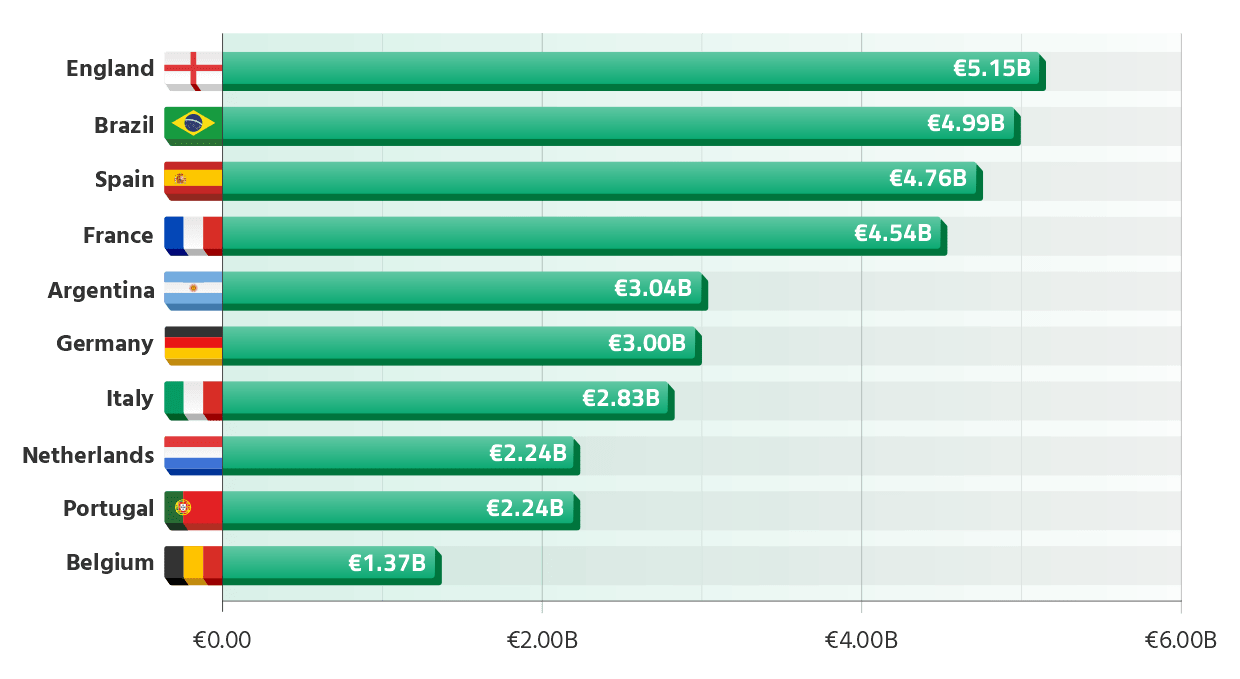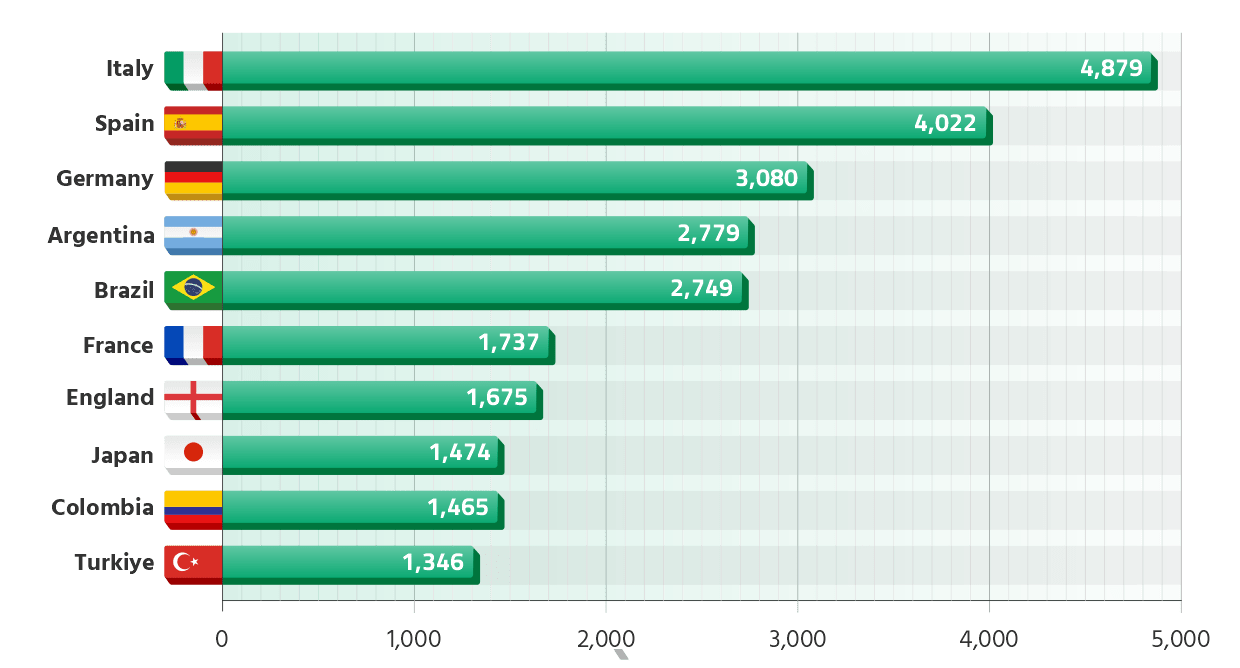With the 2026 World Cup looming, national teams are scrambling for the final few spots at the global showpiece. South America’s qualifiers have already wrapped, while Europe braces for a decisive week that will confirm its final representatives. Against this backdrop, Sportingpedia set out to answer timely questions: which countries are producing the world’s most valuable footballers and which countries have the largest talent pools?
Our latest analysis goes beyond superstar headlines to examine the true depth of global talent. Using up-to-date market values, we ranked nations by the total value of their footballers, the sheer size of their professional player pools, and crucially – the average valuation of players from each country.
While England leads the world in combined player value (€5.15 billion), it is Italy (4,879) and Spain (4,022) that supply the largest number of professionals to the global game. At the same time, nations like Portugal and the Netherlands – despite far smaller talent pools – achieve some of the highest average player values, reflecting the premium placed on their exports.
As the World Cup field narrows, these findings offer a revealing snapshot of the shifting power map in international football – a reminder that quality, not just quantity, is what truly improves the game.
Countries with the highest combined valuations of their footballers (billion)


Data Source: Transfermarkt
When it comes to the sheer market value of their footballers, England holds a narrow edge at the top of the global pyramid. English players combine for a staggering €5.15 billion in value, outpacing all rivals despite the nation’s ongoing wait for international silverware. Brazil – long the gold standard for raw talent and international trophies – runs a close second, with its 2,749 professional footballers collectively valued at €4.99 billion. This rivalry is not just about heritage and World Cups, but the size and price tags of their modern-day exports.
Spain completes the podium, amassing €4.76 billion in player value from a pool of over 4,000 professionals. France, with €4.54 billion, is just behind – reflecting a golden generation powered by global superstars like Kylian Mbappé.
Argentina, the reigning world champions, rank fifth. Their footballers are worth a combined €3.04 billion – nearly €2 billion less than Brazil’s, despite having more players with a market value. Germany, Italy, the Netherlands, Portugal, and Belgium round out the global top ten.
The direct comparisons reveal deeper stories. While Brazil and Argentina are fierce South American rivals on the pitch, the gap in the market value of their footballers is vast – Brazilian talent commands a premium globally, while Argentina’s smaller figure is a product of both a broader base and fewer superstars at the €100m mark. In Europe, Spain’s and Portugal’s player valuations show a similar dichotomy: Spain’s immense pool ensures a high total, but Portugal’s smaller, elite group often fetches higher fees per player (as explored below).
Countries with the highest number of footballers


Data Source: Transfermarkt
If football’s popularity is measured in professionals, Spain and Italy stand alone. Spain boasts 4,022 players with market valuations, while Italy leads the world with 4,879. These two Mediterranean nations have turned their leagues into proving grounds for both homegrown and international talent, with Spain’s La Liga and Italy’s Serie A feeding global markets for decades.
Germany is the only other country to cross the 3,000-player threshold, reflecting both Bundesliga’s depth and the country’s robust youth development infrastructure. England (1,675) and France (1,737) appear much further down this ranking – a reminder that while the Premier League dominate financially, their top-end quality is built on a narrower base.
Brazil (2,749) and Argentina (2,779) reinforce South America’s status as football’s greatest nursery, producing extraordinary numbers of professionals despite economic challenges and domestic league fluctuations.
Notably, the Netherlands (947) and Portugal (802) maintain a more selective approach, preferring quality over sheer numbers – an efficiency reflected in their high average values.
Scandinavian countries such as Sweden (780), Norway (767), and Denmark (679) also make the top 20, highlighting the broad geographic spread of the professional game. The United States, with 982 professionals, leads North America and ranks above Colombia, Morocco, and Turkiye, underscoring the globalisation of the sport and America’s growing export footprint.
Countries with the highest average valuation of their players (million)


Data Source: Transfermarkt
While the headlines favour total value and player numbers, average valuation reveals a subtler – and in many ways more revealing – hierarchy. Here, Portugal emerges as a quiet superpower. The average Portuguese professional is worth €2.79 million, second only to England’s €3.07 million. This reflects a strategic focus on developing technically gifted, export-ready talent – many of whom fetch high fees in European markets.
England’s position at the top is buoyed by its domestic market: Premier League stars command a premium, often inflating the average well above global norms. France also impresses in this category, with its players averaging €2.61 million each – a sign of the enduring strength of its youth academies and the international demand for French talent.
The Netherlands continues to punch above its weight: an average of €2.37 million per player is achieved from fewer than 1,000 professionals, reflecting a system that reliably produces world-class talent. Belgium, too, stands out: despite fewer than 700 players, their average value is over €2 million.
Comparisons sharpen the picture. Portugal’s average value dwarfs that of neighbouring Spain, where the larger player pool brings the average down to €1.18 million. Similarly, Argentina’s world champions average just €1.09 million per player – barely over half of Brazil’s €1.82 million. The German system, despite producing a vast player base, posts an average under €1 million – a sign that depth and development come at the cost of individual headline value.
At the other end, Japan, Italy, and Colombia demonstrate the value of scale, with average valuations between €0.57 and €0.97 million – proof that a wide base does not always guarantee top-tier market value, but ensures a constant supply of professionals worldwide.
| Country | Footballers’ Combined Valuation (billion) | Number of footballers | Average Footballer Valuation (million) |
|---|---|---|---|
| England | €5.15B | 1,675 | €3.07M |
| Brazil | €4.99B | 2,749 | €1.82M |
| Spain | €4.76B | 4,022 | €1.18M |
| France | €4.54B | 1,737 | €2.61M |
| Argentina | €3.04B | 2,779 | €1.09M |
| Germany | €3.00B | 3,080 | €0.97M |
| Italy | €2.83B | 4,879 | €0.58M |
| Netherlands | €2.24B | 947 | €2.37M |
| Portugal | €2.24B | 802 | €2.79M |
| Belgium | €1.37B | 683 | €2.01M |
| Denmark | €1.16B | 679 | €1.71M |
| Uruguay | €1.06B | 1,094 | €0.97M |
| Sweden | €1.03B | 780 | €1.32M |
| Norway | €1.03B | 767 | €1.34M |
| United States | €0.96B | 982 | €0.98M |
| Colombia | €0.93B | 1,465 | €0.63M |
| Morocco | €0.92B | 688 | €1.34M |
| Turkiye | €0.91B | 1,346 | €0.68M |
| Japan | €0.84B | 1,474 | €0.57M |
| Serbia | €0.81B | 1,047 | €0.77M |
Data Source: Transfermarkt